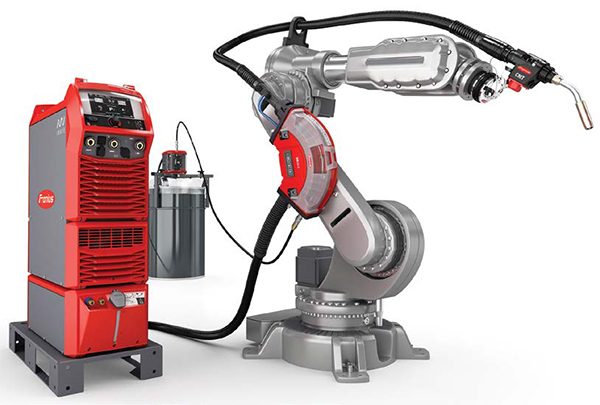Fronius, an innovation leader in arc welding, is celebrating the 20th anniversary of its revolutionary Cold Metal Transfer (CMT) welding process. Since its introduction in 2005, CMT has changed the world of welding and set new standards in precision, stability and versatility.
Click to download and read pdf

For robotic welding, any intelligent Fronius welding machine can be simply retrofitted for CMT using the CMT Welding Software Package, the Robacta Drive CMT torch, and SplitBox SB 60i R hardware components.
The CMT process is based on reversing the wire-feed direction during short-arc welding to enable controlled droplet detachment during the short-circuiting cycle. This movement ensures a stable arc and minimises heat input.
This results in almost spatter-free, clean welds that have high quality and aesthetics. Another advantage of the CMT process is the low thermal load on the workpiece. This reduces distortion and deformation, which is an enormous advantage, especially when working with sheets as thin as 0.3 millimetres and temperature-sensitive materials. Precise control of the welding process helps tackle demanding welding tasks with the highest degree of accuracy.
CMT opens up the possibility of joining different materials together. For example, galvanised steel and aluminium can be welded safely and reliably. This creates scope for creative solutions in the production process.
A variety of applications in different industries
“Over the last two decades, CMT has established itself as a versatile welding process that is used in numerous industries. Sometimes, even we are impressed by the diversity and creativity with which our customers use CMT to their advantage and to solve their welding challenges,” says Franziska Eichhorn, Strategic Product Manager for Fronius International.
The automotive industry, for example, uses CMT to join thin sheets and lightweight materials such as aluminium, ensuring strong and reliable connections for vehicle frames and components.
CMT has also proven its worth in the aerospace industry, where the process allows the welding of high-strength and lightweight materials that are essential for the construction of aircraft and spacecraft.
In addition, due to the outstanding stability of the welding process, CMT is used for 3D printing/additive manufacturing, and in the electronics industry, where it is used to braze components precisely.
Intelligent air gap and edge detection
CMT’s back-and-forth movement of the wire has also revolutionised robotic welding with the WireSense intelligent assistance system. This significantly improves seam quality and efficiency by detecting inaccuracies and deviations in industrial production and avoiding them using the CMT welding process. The welding wire serves as a precise sensor that can very accurately determine the position of the weld and dynamically adjust it. This saves material, time and costs, as rework and rejects are reduced.
CMT is fit for the future
“The decisive factor is the perfect interaction of the components and the precision with which they are controlled,” emphasises Eichhorn. “The harmony with which our intelligent welding machines and the CMT Robacta Drive unit –the second wire feeder mounted inside the torch – work together is still unmatched today and is constantly being further developed to meet the increasing demands of industry. And the best thing about it: CMT can be easily retrofitted to all intelligent Fronius devices,” adds Eichhorn.
Over the years, Fronius has continued to perfect CMT and developed application-specific optimised welding characteristics such as CMT Mix, CMT Cycle Step, CMT Cladding and CMT Braze.
Laser Hybrid CMT, on the other hand, combines the advantages of laser welding with CMT technology. When used on high-strength steels and aluminium components, this combination boasts high speed, quality and cost-effectiveness. A highly focused laser beam that penetrates the base material with a high energy density is immediately followed by the CMT process, which increases the seam volume and can further reduce the heat input.
The latest achievements are the CMT Additive Pro characteristics, which are optimised for metal 3D printing, taking additive manufacturing to a new level.